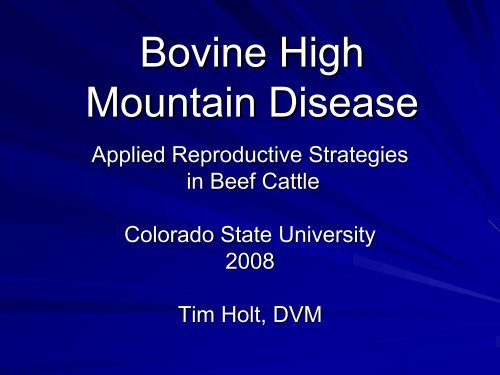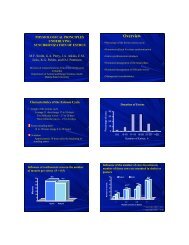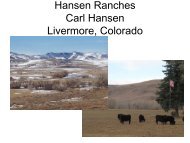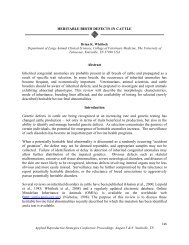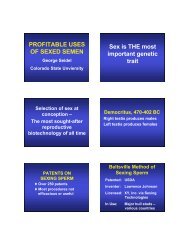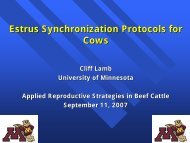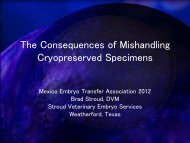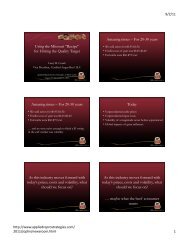Bovine High Mountain Disease
PowerPoint - Applied Reproductive Strategies in Beef Cattle
PowerPoint - Applied Reproductive Strategies in Beef Cattle
You also want an ePaper? Increase the reach of your titles
YUMPU automatically turns print PDFs into web optimized ePapers that Google loves.
<strong>Bovine</strong> <strong>High</strong><br />
<strong>Mountain</strong> <strong>Disease</strong><br />
Applied Reproductive Strategies<br />
in Beef Cattle<br />
Colorado State University<br />
2008<br />
Tim Holt, DVM
<strong>Bovine</strong> <strong>High</strong> <strong>Mountain</strong> <strong>Disease</strong><br />
(BHMD)
Pathophysiology<br />
BHMD<br />
Hypoxia<br />
Pulmonary Vasoconstriction<br />
Pulmonary Remodeling<br />
Pulmonary Hypertension<br />
Right Ventricular Hypertrophy<br />
Right Ventricular Dilation<br />
Right Heart Congestive Failure
Normal<br />
Pulmonary Artery<br />
Smooth Muscle<br />
PAP-40 mmHg<br />
Hypoxic exposure<br />
Hypertrophy of<br />
Pulmonary Artery<br />
Smooth Muscle<br />
PAP-80 mmHg
40 mmHg PAP<br />
(Normal)<br />
Pulmonary Vasculature<br />
80 mmHg PAP<br />
(Vasoconstriction)<br />
Pulmonary Hypertension
PA Pressure and Vascular Volume in Resistant and<br />
Susceptible Lowland Cattle Transported to <strong>High</strong> Altitude
Jugular Distension
Necropsy findings
Treatment<br />
Diuretics<br />
Antibiotics<br />
Warming environment<br />
Limited water and salt intake<br />
Thoracocentesis<br />
TLC - supportive care<br />
Move to lower elevation<br />
Other ????
Confounding Factors<br />
Viral Respiratory <strong>Disease</strong><br />
– IBR, BVD, PI-3, BRSV<br />
Bacterial Respiratory <strong>Disease</strong><br />
– Mannheimia, Pasteurella, Mycoplasma,<br />
Haemophilus, E.Coli<br />
Parasites<br />
– Migrating GI larva and lung worm<br />
Chronic Cold Temperatures<br />
COPD, Asthma (fog Fever)<br />
Chronic Illness
Confounding Factors continued<br />
Metastatic Pneumonia<br />
– Liver abscesses<br />
– Vena Caval Syndrome<br />
Traumatic Reticuloperitonitis/Pleuritis<br />
Lung Abscesses<br />
Plant Toxins<br />
Genetics
Why PAP Test?<br />
Economic Impact!!<br />
Predict BHMD risk<br />
Cull animals at risk to reduce herd<br />
economic impact<br />
Selective breeding (heritable)<br />
Pathophysiology and potential therapies
PAP Testing Rocks?<br />
IT’S S FUN<br />
IT’S S EXCITING<br />
IT’S S NOT WITHOUT<br />
RISK AND<br />
COMPLICATIONS<br />
INVASIVE<br />
ENVIROMENTAL<br />
STRESSES<br />
RELIENT ON<br />
ALTITUDE<br />
AI SIRES
Economic Impact<br />
(> 6500 ft)<br />
Calf loss due to altitude exposure<br />
– 5% Average Annual Calf Death<br />
– 3 - 35% Range<br />
Potential Losses<br />
– $960.00 = 800 pound yearling<br />
– 300 head herd<br />
– 3 - 35%<br />
– 9 - 105 head<br />
–$8,640<br />
- $100,800 per year
Example Herd 2/6/05<br />
214 Black Angus pregnant cows purchased from<br />
Nebraska, moved to San Luis Valley elevation<br />
8000 feet<br />
Arrived at ranch 01/06/05: as of 2/6/05<br />
– 6 died from BHMD<br />
Total Loss $20,400<br />
– Culls due to PAP scores<br />
7 cows culled<br />
– PAP measurements >100<br />
– with cardiac murmur<br />
Total Loss $17,500<br />
Total Loss to Ranch from BHMD = $37,400 within<br />
30 days of arrival to altitude
Decision Making Time<br />
To cull or not to cull . . .<br />
<strong>High</strong> risk BHMD animals<br />
– 32% (n = 68)<br />
– PAP = 48 mmHg PAP<br />
Total Value<br />
– $171,000<br />
NOW WHAT?
Jugular distension<br />
Red Angus Calf<br />
27% Death loss in one year<br />
(117 / 435 >$100,000.00)
PAP Testing Adventures<br />
1980 in<br />
Gunnison/Hesperus<br />
Colorado<br />
1980-Present, >193,000<br />
head<br />
Ambient Temps -42<br />
degrees to 103<br />
degrees.<br />
Numerous Breeds with<br />
high Pap's in all<br />
Elevations from 800-<br />
12,700 feet (14,000<br />
feet)
PAP Measurement Evaluation<br />
Altitudes >6400 ft<br />
30-35mmHg<br />
35mmHg<br />
– Low Risk score and highly reliable and repeatable.<br />
36-39mmHg<br />
39mmHg<br />
– Low risk score if animal is >12months of age, reliable<br />
and repeatable.<br />
40-41mmHg<br />
41mmHg<br />
– Low to moderate risk if animal is >12months of age<br />
but retesting is recommended.
PAP Measurement Evaluation<br />
42-45mmHg<br />
45mmHg<br />
– Acceptable but moderate risk for animals 16 months of<br />
age.<br />
45-48mmHg<br />
48mmHg<br />
– Moderate to high risk area, retesting advised up to 24<br />
months of age<br />
>49mmHg<br />
– <strong>High</strong> risk area for any age and any elevation, poor<br />
repeatability, rare false high readings
Risk Factors<br />
• Youth<br />
• Altitude<br />
• Viral, bacterial or parasitic illness<br />
• Body Condition (over or under conditioning)<br />
• Breed<br />
• Gender<br />
• Nutrition (ionophores?)
Age Effects<br />
12months<br />
– Elevations >6500 feet
Concurrent Illness<br />
Any respiratory disease will increase PAP<br />
measurement.<br />
Parasitic influence<br />
– Lung and Intestinal
Enviromental Conditions
Plant Toxins<br />
Locoweed<br />
– Swainsonine<br />
– Indolizide Alkaloid<br />
– Inhibits the enzyme alpha-mannosidase<br />
– Oligosacharide storage disease
Body Condition<br />
Excessive body condition increases PAP<br />
– Bulls on Test<br />
– Feedlot Cattle
Found in All Breeds<br />
Breed
Gender<br />
No difference Male<br />
vs. Female<br />
Recent change<br />
Steers and cross<br />
breeds lower
Heritability<br />
DNA and RNA studies<br />
Autosomal dominant<br />
Variable Penetrance<br />
Predictable<br />
Natural Culling<br />
Common questions<br />
“If cattle are born and raised at high altitude, are<br />
they resistant?<br />
If cattle have lived there for years how can they<br />
be carriers or of any concern?
Heritability<br />
PAP=113<br />
PAP=83
Bull #94<br />
PAP of 83mmHg<br />
Clinical signs of HMD<br />
Purchase Price = $9700.00<br />
Current Value = $600.00<br />
– if he makes it to the sale and is not<br />
condemned<br />
No bred cows (a good thing ??)
Bull #5<br />
Full Brother<br />
PAP 113 mmHg<br />
Non-clinical at this time.<br />
– Paid $9000.00 for him<br />
– Worth $900.00 at sale<br />
– Use as breeding bull?<br />
– Prognosis?<br />
– Heritability? Calf loss……<br />
– Sale to lower altitude?
Pedigree
Clinical Progression
Annual Herd PAP Evaluation<br />
Annual PAP Data<br />
90.00<br />
80.00<br />
70.00<br />
60.00<br />
PAP<br />
50.00<br />
40.00<br />
30.00<br />
20.00<br />
10.00<br />
0.00<br />
1989 1990 1991 1992 1993 1994 1995 1996 1997 1998 1999 2001 2002 2004<br />
YEAR
Sire Evaluation Data<br />
SIRE PAP ELEVATION DAM'S SIRE BREED YEAR<br />
ALLIANCE 6595 56 7600 MENTOR 1425 BA 2000<br />
ALLIANCE 6595 40 7600 PAYCHECK 8271 BA 2000<br />
ALLIANCE 6595 47 7600 LEACHMAN VOLUNTEER BA 2000<br />
ALLIANCE 6595 40 7600 RAINMAKER D S 450W BA 2000<br />
ALLIANCE 6595 45 7800 LEACHMAN VOLUNTEER BA 2001<br />
ALLIANCE 6595 40 7800 MONTANA POWER 885 BA 2001<br />
ALLIANCE 6595 39 7800 PAYCHECK 876W OF J R S BA 2001<br />
ALLIANCE 6595 51 7800 MONTANA POWER DS 149 BA 2001<br />
ALLIANCE 6595 51 7800 RITO 324 BA 2001<br />
ALLIANCE 6595 36 7800 S V F REGENCY BA 2001<br />
ALLIANCE 6595 36 7800 S V F REGENCY BA 2001<br />
ALLIANCE 6595 37 7800 APPROVAL 170B BA 2001<br />
Mean 43.17<br />
Standard Deviation 6.70
Sire Summaries<br />
Bull<br />
Mean PAP<br />
Range<br />
SD<br />
DYF 37.53 32-47<br />
3.31<br />
Math 39.11 31-52<br />
3.8<br />
Alliance 43.16 36-56<br />
6.69<br />
BootJack 50.68 36-120<br />
20.35<br />
Mr. Angus 53.72 34-117<br />
24.00
ALTERNATIVES TO PAP<br />
why<br />
TESTING
DNA Identification<br />
Genetics<br />
Basis of Hypoxic<br />
Pulmonary<br />
Hypertension:<br />
“The Brisket Gene”
Questions
Thank You !!


